View current page
...more recent posts
The interview Paddy Johnson did with Michael Bell-Smith and me has concluded, but I want to address one point Mike raised at the end, so I'm carrying the discussion over to my page. The other participants have blogs and can do the same.
MBS: [...] The work in the [Foxy Production] show was created with a gallery in mind and I wanted it to feel that way. Rather than playing off the tensions of bringing new media into the gallery - as I feel Tom has with his show – I wanted it to feel like a natural fit, again, like maybe this is just how we make art these days.
I don’t think flat screens in a gallery feel especially high tech. For me they’re less loaded than traditional TVs/monitors (which feel consciously lo-tech), high end CRT NTSC monitors (which tie into a history of video art in the gallery) or large projections (which feel cinematic or as Tom pointed out, aggressive).
For me, the containment of wall-mounted flat screen monitors is about putting the work on a physical and spatial par with painting, drawing or photography. I think creating that kind of familiar physical relationship between the viewer and the work may serve to combat the tech gap: at the very least the viewer knows how to deal with the piece on a physical level. [...]
TM: These are good points. I want to add that, although I recently did a blog post called "Showing new media work in a gallery: what's at stake," that isn't the main content of my show, any more than Mike's content was his delivery system. The gear I used is to deliver the strongest statement--which is to say, to get the most out of the pulsing abstractions, repurposing of a Star Trek sensor as a "simulacratracker" (as one commenter described it), and the embarassing acting out (or faux acting out) of Guitar Solo (which actually is on a tiny flat screen). I've argued with a couple of people about my use of tube TVs instead of LCDs for three of the pieces. I chose the tubes because they deliver a punchy image, punchier to me than what I'm seeing on flats these days. Tubes aren't that "retro"--J&R Music and Video still has a wall of CRTs for sale as an alternative to the wall of LCDs. I know, it won't last, but we're talking about the present. Translating animated GIFs from a computer to a single dedicated image on a TV adds an element of the unexpected, and a gritty texture I like. These choices aren't just to emphasize "new media in the gallery"--although that's definitely an aspect of the content.
One of my recent "out and about" pics is the Photo of the Week on NewMusicBox, the website of the American Music Center. Thanks to Molly Sheridan for the linkage.
"It's a number."
Here was the interchange with the White House press secretary after the number of Americans who died fighting the Cheney Administration's war of choice, against a country that did not theaten us, passed the 2,500 mark:
Q Tony, American deaths in Iraq have reached 2,500. Is there any response or reaction from the President on that?There really aren't words for how monstrous these people are. Not "the troops"--the people who needlessly put them in harm's way and justify their continued slaughter with this weak BS. To say nothing of the Iraqi civilian casualties, which the most conservative estimates put at an insane 38,000 to 42,000.
MR. SNOW: It's a number, and every time there's one of these 500 benchmarks people want something. The President would like the war to be over now. Everybody would like the war to be over now. And the one thing that we saw in Iraq this week is further testimony to the quality of the men and the women who are doing that, and the dedication and determination to try to ensure that the people of Iraq really do live in a free, effective democracy of their own creation and design.
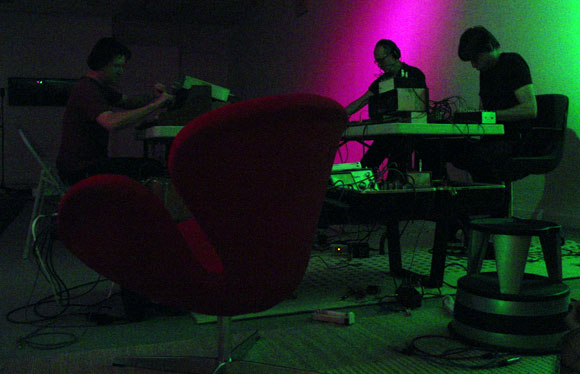
Photos taken last night at Analogos, a program of all analog, abstract synth music at Diapason, on 6th Avenue. The program was billed as "a night of 'vintage' (and other) analog synthesis." Above, left to right: Michael J. Schumacher (Steiner-Parker Synthacon); Ed Tomney (EMS VCS3 "Putney," various), and David Galbraith (selfbuilt electronics). Performing but not pictured: Tom Hamilton (Sherman Filterbank). The piece they're playing conjured electronic jungle birds morphing into synthetic clattering traffic sounds; the perfomers listened attentively to each other as these moods changed, or so it seemed from where I was sitting. Also nice was a duet between Galbraith and Hamilton where the output from the former's homemade synth circuitry was fed live through the latter's filtering apparatus--a subtle, somewhat lyrical piece. A later trio between Tomney, Schumacher, and James Fei on Buchla synth was like being inside a tornado, with airborne Geiger counters zizzing around. (If I'm not mistaken it was the VCS3 producing those sublime hypnotic swooshing sounds.) And finally, a duet between Barry Weisblat (pictured below with homemade electronics) and Kato Hideki on Octave "Cat" synth and pedals provided the evening's rock and roll skronk notes, as Hideki "got down." This was a great evening, some beautiful, dense textures and not a MIDI clock to be heard--it was all voltages providing the rhythms.
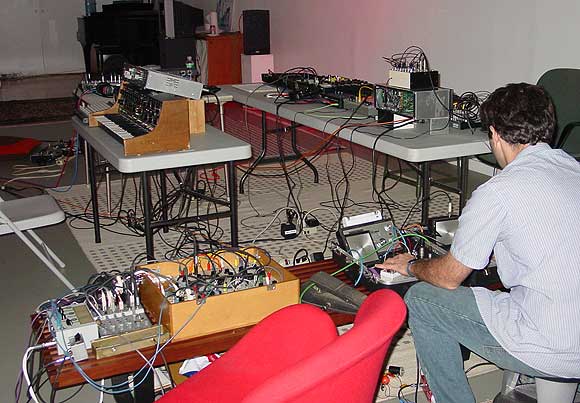
"Your Haploid Heart"
Fascinating article in Bookforum about CIA employee Alice Sheldon, who wrote science fiction under the name James Tiptree, Jr. The essay, discussing a recent bio by Julie Phillips, connects the themes of Tiptree's fiction to Sheldon's early life as the daughter of a writer/explorer traveling in Africa and Asia. I've only read one Tiptree story and didn't like it much but the story of her double life is intriguing, particularly the way political themes that could never been expressed in her "day job" got worked out in her fiction. It would be interesting to compare Tiptree's work to that of Paul Linebarger, another DC spook-type who wrote SF (as Cordwainer Smith). Sheldon was a Star Trek fan and I like this passage from the review:
"It was partly from colonial adventure stories like [Sheldon's mother's] that science fiction was born," Phillips observes. "The first time Alice saw Star Trek, she recognized it at once as a story about her childhood." This observation, like so many in this superb biography, strikes deep. It illuminates one of the darker corners of science fiction—its political unconscious, as it were. The writer's bible for Star Trek couldn't be clearer about the colonial echo: "Horatio Hornblower in space." The multicultural crew may look like it's been sent by the United Nations, but its gunship could wipe out a planet.But what about the Prime Directive? One thing I didn't know about Sheldon's life was how it ended. She feared aging and caring for a husband twelve years her senior, so they had a "suicide pact" in 1987 that the review suggests might have been a murder/suicide (Sheldon shot him and then herself). But her fiction seems every bit as renegade and "difficult" as that juicy story--I'm now eager to read more of it.
The early story "Your Haploid Heart" combines the love-death theme with another one of Tiptree's obsessions: the willingness of rational beings to exterminate "inferior" races in the name of progress. Representatives of the Galactic Federation have come to see if aliens they contacted generations ago qualify for admission to the Federation. Only "human" races do. It's the same question that preoccupied nineteenth-century colonialists: Are the natives human? The Federation's definition of human is sexual; if a race can interbreed with humans, it is human. The Esthaans are so eager to be accepted that ever since first contact with the Federation they've hidden a dirty secret—the inferior Flenni race that dwells on their planet. In truth, the Esthaans reproduce like mosses: They bud asexually to produce sexually active offspring, the Flenni, who are in turn the parents of the Esthaans (and who are, in fact, sexually compatible with humans). This biological fact is so inconvenient and repulsive to Esthaan ambitions that it has been repressed, and the Esthaans are on the verge of exterminating the Flenni, even though the consequences would be suicidal. Once again, the armature of this story is standard-issue SF—a single scientific fact, in this case the diploid-haploid reproductive cycle, is extrapolated, and its consequences drive the plot. But the depiction of psychosexual madness is an exceptional departure from the genre's norms. And a further barb: This lunacy was brought by the Federation with its offer, Be like us.Below, detail of a portrait of Alice Sheldon by Patti Perret, from The Faces of Science Fiction, 1984:
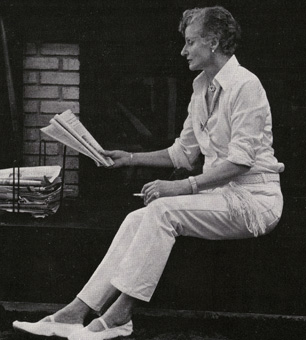
Part Three of Paddy Johnson's interview with Michael Bell-Smith and me is here. Here's an excerpt, slightly editorially massaged to reflect a clarification of terminology later in the interview:
[Michael Bell-Smith]: For many people (techies and lay folk alike) issues of authenticity and technique are on the surface of all digital work. Digital is akin to magic: the magic of the desktop computer, the magic of cinema special fx, the magic of the internet, and with that magic - what Tom [is calling] the "tech gap" - is often skepticism and anxiety. One way I try to counter that gap is [via] lo-res graphics, basic movement, slow pacing. (Up and Away, for instance, from a mechanical standpoint, is no more than a series of still images moving from the top of the screen to the bottom.)Meanwhile, in this comment thread, we've been batting around a "movement name" for "recent developments in net art/new media that are making small incursions into the gallery art world." We have some good trial balloons; eventually I'll summarize them. Contributions are welcome--please add them to the thread.
It's an attempt at letting the seams show, a step towards the folk art approach that the artist drx (by way of Tom) has advocated. My hope is that an audience might have a better understanding of "what's going on" and can therefore engage the work from other angles.
A nice side effect of this, is that once you begin to suss out what's going on, you might begin to think about other forms of digital mediation in your life, and wonder how those work, and wonder if you've ever seen their seams, and if not, why not?

Frankie Martin, "kitty_kat" [YouTube]. Dorky and lascivious. I like the scrolling urban backgrounds inhabiting different perspective spaces from the foregrounds, the cat wallpaper, the exquisite Naughty by Nature song, and....the hot women in cat costumes.
Update, 2011: The video was removed from YouTube on "copyright grounds."
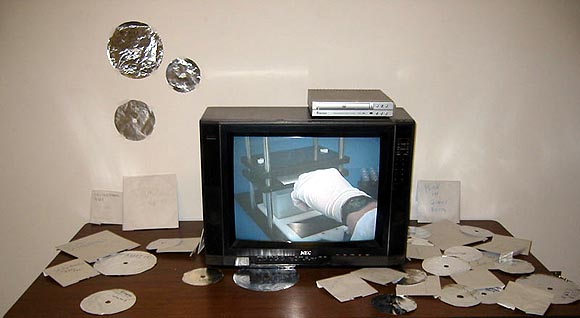
Some new Guthrie Lonergan videos here. Above is how these YouTube-friendly works were displayed in "real space"--surrounded by tinfoil DVDs and CDs. The videos have a powerful mood--it's Lonergan's original music, and the matter-of-fact way they're put together. The "office party" one almost makes me cry. I think office stuff is important content right now--it's one ethnographic Other the art world can't face and doesn't want to celebrate and assimilate the way it has every other exotic culture. The depressing environment from whence cometh the bacon of the owner class. Signed, Karl Marx Jr.
Below, more Internet content reified and cargo-culted into the physical world. A couple of Lonergan web pages saved via a screen cap program and made into collages. The one on the left is Halt, Robot!, his collection of bot-deterring "read me before you can post" typography, mostly from MySpace. The web page the collage on the right is based on hasn't been posted yet. I like the craft project vibe of these pieces.
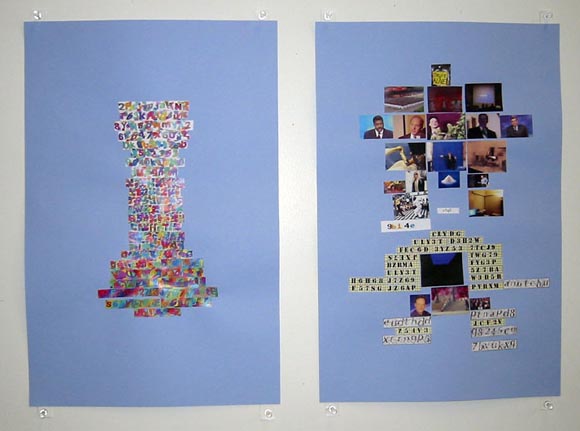
Lonergan has also been collecting MySpace intros. I really don't know how to talk about this work. I feel a bit like James Stewart in Rear Window watching these normal people doing their awkward and occasionally very funny home movie bits to introduce themselves to a million total strangers. It's completely public domain but feels invasive somehow.
